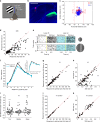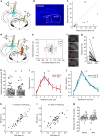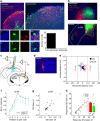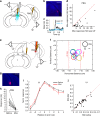Functional modulation of primary visual cortex by the superior colliculus in the mouse
- PMID: 30254324
- PMCID: PMC6156231
- DOI: 10.1038/s41467-018-06389-6
Functional modulation of primary visual cortex by the superior colliculus in the mouse
Abstract
The largest targets of retinal input in mammals are the dorsal lateral geniculate nucleus (dLGN), a relay to the primary visual cortex (V1), and the superior colliculus. V1 innervates and influences the superior colliculus. Here, we find that, in turn, superior colliculus modulates responses in mouse V1. Optogenetically inhibiting the superior colliculus reduces responses in V1 to optimally sized stimuli. Superior colliculus could influence V1 via its strong projection to the lateral posterior nucleus (LP/Pulvinar) or its weaker projection to the dLGN. Inhibiting superior colliculus strongly reduces activity in LP. Pharmacologically silencing LP itself, however, does not remove collicular modulation of V1. The modulation is instead due to a collicular gain modulation of the dLGN. Surround suppression operating in V1 explains the different effects for differently sized stimuli. Computations of visual saliency in the superior colliculus can thus influence tuning in the visual cortex via a tectogeniculate pathway.
Conflict of interest statement
The authors declare no competing interests.
Figures





Similar articles
-
Distinct cell types in the superficial superior colliculus project to the dorsal lateral geniculate and lateral posterior thalamic nuclei.J Neurophysiol. 2018 Sep 1;120(3):1286-1292. doi: 10.1152/jn.00248.2018. Epub 2018 Jun 13. J Neurophysiol. 2018. PMID: 29897837 Free PMC article.
-
A Differential Circuit via Retino-Colliculo-Pulvinar Pathway Enhances Feature Selectivity in Visual Cortex through Surround Suppression.Neuron. 2020 Jan 22;105(2):355-369.e6. doi: 10.1016/j.neuron.2019.10.027. Epub 2019 Dec 4. Neuron. 2020. PMID: 31812514 Free PMC article.
-
Dissecting the circuit for blindsight to reveal the critical role of pulvinar and superior colliculus.Nat Commun. 2019 Jan 11;10(1):135. doi: 10.1038/s41467-018-08058-0. Nat Commun. 2019. PMID: 30635570 Free PMC article.
-
The Second Visual System of The Tree Shrew.J Comp Neurol. 2019 Feb 15;527(3):679-693. doi: 10.1002/cne.24413. Epub 2018 Mar 9. J Comp Neurol. 2019. PMID: 29446088 Free PMC article. Review.
-
The mouse pulvinar nucleus: Organization of the tectorecipient zones.Vis Neurosci. 2017 Jan;34:E011. doi: 10.1017/S0952523817000050. Vis Neurosci. 2017. PMID: 28965504 Free PMC article. Review.
Cited by
-
Involvement of superior colliculus in complex figure detection of mice.Elife. 2024 Jan 25;13:e83708. doi: 10.7554/eLife.83708. Elife. 2024. PMID: 38270590 Free PMC article.
-
Cortical-subcortical interactions in goal-directed behavior.Physiol Rev. 2023 Jan 1;103(1):347-389. doi: 10.1152/physrev.00048.2021. Epub 2022 Jun 30. Physiol Rev. 2023. PMID: 35771984 Free PMC article. Review.
-
Role of posterior medial thalamus in the modulation of striatal circuitry and choice behavior.Elife. 2025 May 13;13:RP98563. doi: 10.7554/eLife.98563. Elife. 2025. PMID: 40359003 Free PMC article.
-
Retinogenesis of the Human Fetal Retina: An Apical Polarity Perspective.Genes (Basel). 2019 Nov 29;10(12):987. doi: 10.3390/genes10120987. Genes (Basel). 2019. PMID: 31795518 Free PMC article. Review.
-
A subcortical switchboard for perseverative, exploratory and disengaged states.Nature. 2025 May;641(8061):151-161. doi: 10.1038/s41586-025-08672-1. Epub 2025 Mar 5. Nature. 2025. PMID: 40044848 Free PMC article.
References
Publication types
MeSH terms
Substances
Grants and funding
LinkOut - more resources
Full Text Sources
Other Literature Sources
Molecular Biology Databases

